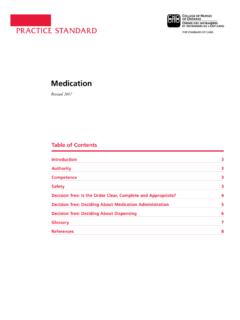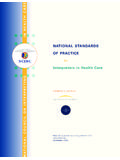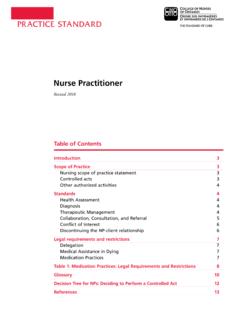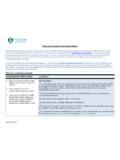Transcription of Standard Implementation Protocol for Medication …
1 The High5s Project Standard Operating Protocol for Medication Reconciliation Page 1 of 36 The High5s Project Standard Operating Protocol for Medication Reconciliation Page 2 of 36 Standard Operating Protocol Assuring Medication Accuracy at Transitions in Care The Standard Operating Protocol was the primary reference document for hospitals and Lead Technical Agencies (LTAs) participating in the WHO High5s project. It outlines the Standard steps of Medication reconciliation, guidance for Implementation , references and suggestions for quality improvement. This document and the Getting Started Kit are provided to assist more organizations to implement Medication reconciliation.
2 Acknowledgement This work was carried out as part of the High 5s Project set up by the World Health Organization in 2007 and coordinated globally by the WHO Collaborating Centre for Patient Safety, The Joint Commission in the United States of America, with the participation of the following Lead Technical Agencies including: Australian Commission on Safety and Quality in Health Care, Australia; Canadian Patient Safety Institute, Canada and the Institute for Safe Medication Practices Canada, Canada; National Authority for Health- HAS, France, with CEPPRAL (Coordination pour L Evaluation des pratiques professionnelles en sant en Rh ne-Alpes), France, OMEDIT Aquitaine (Observatoire du Medicament, Dispositifs medicaux et Innovation Therapeutique), France (from 2012- 2015) and EVALOR (EVAluation LORraine), France (from 2009-2011); German Agency for Quality in Medicine, Germany and the German Coalition for Patient Safety, Germany; CBO Dutch Institute for Healthcare Improvement, the Netherlands; Singapore Ministry of Health, Singapore.
3 Trinidad and Tobago Ministry of Health, Trinidad Former National Patient Safety Agency, United Kingdom of Great Britain and Northern Ireland; and the Agency for Healthcare Research and Quality, USA. This work is a part of the High 5s Project which has been supported by the Agency for Healthcare Research and Quality, USA, WHO, and the Commonwealth Fund, USA. The following Standard Operating Protocol (SOP) was developed, tested and refined for use within the context of the WHO Action on Patient Safety ( High5s ) initiative, an internationally coordinated, limited participation activity for testing the feasibility of implementing standardized patient safety protocols and determining the impact of the Implementation on certain specified patient safety outcomes.
4 Because the efficacy of this and other High5 SOPs has now been demonstrated, their Implementation outside of the WHO High5s testing environment is encouraged. The High5s Project Standard Operating Protocol for Medication Reconciliation Page 3 of 36 Table of Contents 1. DESCRIPTION OF THE PATIENT SAFETY PROBLEM TO BE ADDRESSED ..4 2. A WORD ABOUT STANDARDIZATION ..6 3. GUIDING PRINCIPLES FOR Implementation OF Medication RECONCILIATION ..7 4. THE CONTEXT FOR Medication RECONCILIATION ..9 5. DETAILED SPECIFICATIONS FOR THE STEPS IN THE Medication RECONCILIATION .. 10 STEP 1: BEST POSSIBLE Medication HISTORY (BPMH) .. 10 STEP 2: VERIFYING AND DOCUMENTING THE HISTORY.
5 11 STEP 3: Medication RECONCILIATION AT ADMISSION .. 11 STEP 4: SUPPLY ACCURATE INFORMATION .. 13 6. PATIENT AND FAMILY INVOLVEMENT .. 14 7. EDUCATION AND TRAINING OF STAFF .. 15 8. Implementation STRATEGY FOR Medication RECONCILIATION .. 16 9. OVERSIGHT OF THE Implementation .. 17 10. PROJECT WORK 18 11. RISK ASSESSMENT OF THE PROPOSED PROCESS .. 19 12. PILOT TEST OF THE Medication RECONCILIATION PROCESS (RECOMMENDED, BUT OPTIONAL .. 20 13. SPREAD METHODOLOGY .. 21 14. COMMUNICATION PLAN .. 22 15. PROCESS MANAGEMENT STRATEGY .. 23 16. MAINTENANCE AND IMPROVEMENT STRATEGY .. 24 APPENDIX A: TABULAR LISTING OF STEPS IN THE Medication RECONCILIATION PROCESS ON ADMISSION.)
6 28 APPENDIX B: FLOW CHARTS OF THE Medication RECONCILIATION PROCESS .. 29 STEP I. CREATING A BEST POSSIBLE Medication HISTORY (BPMH) ON ADMISSION .. 29 STEP II A. Medication RECONCILIATION AT ADMISSION (PROACTIVE MODEL).. 30 STEP II B. Medication RECONCILIATION AT ADMISSION (RETROACTIVE MODEL) .. 30 STEP III. Medication RECONCILIATION AT INTERNAL TRANSFER .. 31 STEP IV. Medication RECONCILIATION AT DISCHARGE .. 32 STEP V. PATIENT INVOLVEMENT POST-DISCHARGE & PRIOR TO NEXT EPISODE OF CARE .. 33 END NOTES .. 35 The High5s Project Standard Operating Protocol for Medication Reconciliation Page 4 of 36 1. Description of the patient safety problem to be addressed Medication reconciliation is the formal process in which health care professionals partner with patients to ensure accurate and complete Medication information transfer at interfaces of care.
7 Adverse drug events (ADE) are a leading cause of injury and death within health care systems around the ,2,3 Many of these events occur as a result of poor communication between health professionals and between health professionals and patients and/or carers when care is transferred, such as when patients are admitted to hospital, move between wards and are discharged home to the community or a residential care facility home. Around half of the Medication errors that occur in hospital are estimated to occur on admission or discharge from a clinical unit or hospital4 and around 30% of these errors have the potential to cause patient ,6 These errors can occur when obtaining the patient s Medication history ( on admission to hospital), when recording the medicines in the medical record, and when prescribing medicines on admission, on transfer to another ward and at discharge.
8 Up to 67% of patients prescription Medication histories recorded on admission to hospital have one or more errors and 30 80% of patients have a discrepancy between the medicines ordered in hospital and those they were taking at When a patient s transition from the hospital to home is inadequate, the repercussions can be far-reaching hospital readmission, an adverse drug event, and even ,9 Several national European studies of adverse events in different countries revealed that between of hospitalized patients have suffered at least one adverse event during their admission and that between of these adverse events were caused by medications which were It is well known that adverse drug events (ADE)
9 Are a leading cause of injury and death in healthcare and that communication problems between settings of care are a significant factor in their ,12 , 13 ,14 Sixty-seven percent of patients Medication histories have one or more errors15 and up to 46% of Medication errors occur during prescription at patient admission or Chart reviews reveal that over half of all hospital Medication errors occur at the interfaces of The cost estimates from Europe and North America, have found that Medication overuse, underuse and misuse costs billions of dollars. Yet, little work is being undertaken to understand and address this In America costs related to the million people that are harmed and thousands that are killed are estimated at billion Medication History Verify History Updates During Treatment Discharge Medication Plan Action on Patient Safety (High5s)
10 - Medication Reconciliation SOP Version 3, September 2014 Page 5 of 36 A European study in six countries involving 900 consecutive patients admitted to university teaching hospitals showed a range from 22% to 77% of potentially inappropriate prescribing in the While the elderly are overrepresented in terms of patient numbers, this group is underrepresented or even excluded from many clinical trials that generate the evidence-base for health care interventions. Erroneous Medication histories can lead to discontinuity of therapy, recommencement of discontinued medicines, inappropriate therapy and failure to detect a drug related problem.















